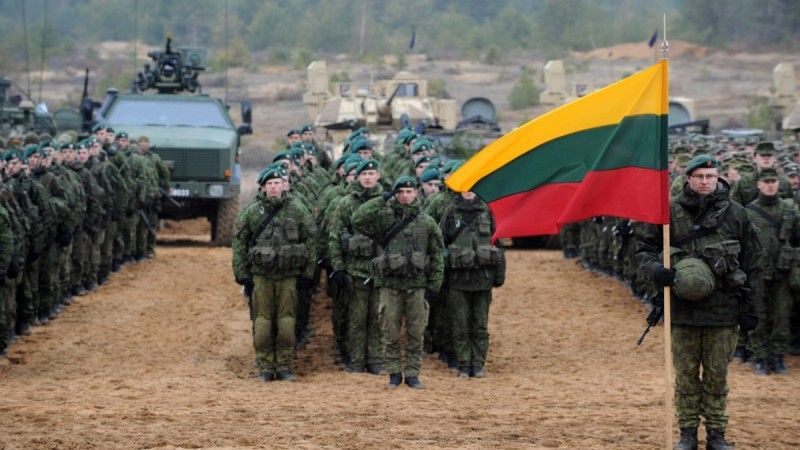Geopolitics
How the Balts are getting ready for war. Purchasing equipment is not everything

The Baltic States remain at the forefront of supporting Ukraine. This is nothing extraordinary if you recall the words of Volodymyr Zelensky who emphasized that after Ukraine, the next countries attacked will be Lithuania, Latvia and Estonia, and later also Poland. Despite the stationing of NATO troops and investments in armaments in recent years, it is still not enough. The Balts want to be ready for an attack from Russia now.
By 2027, Lithuania plans to spend over EUR one billion on purchases of military equipment from Germany and the U.S. The Lithuanian government intends to acquire infantry fighting vehicles, PzH2000 self-propelled howitzers, Switchblade drones, Javelin medium-range antitank systems, new radars or four UH-60M Black Hawk multi-role helicopters, among others. It will also buy 18 new generation 155-mm Caesar self-propelled wheeled howitzers. The estimated cost is to be up to EUR 150 million. Thus, Lithuania will join the new generation artillery system development program CAESAR Mark II of the French Directorate General of Armaments. The technical agreement on Lithuania's contribution to the Caesar development program is to be signed before July 30. At the same time, an agreement is being prepared with the French manufacturer of ammunition and weapon systems Nexter. The Lithuanian Ministry of Defense has also started negotiations on the purchase of more than 120 Boxer armored fighting vehicles. The contract is to be signed by the end of summer, and the first deliveries are to take place in 2023 and 2024.
The defense ministers of Lithuania and Poland announced in May that joint purchases of weapons are being considered. Both countries also emphasize cooperation and commitment to the "Suwalki isthmus." NATO troops are stationed on both the Polish and Lithuanian side, including the Mobile Command Post of the Multinational Division North-East. During his July visit to the units, the Lithuanian president stated that "Lithuania and Poland will stand together to defend every inch of our territories."
Lithuanians have long-term thinking when it comes to defense issues, which is why in mid-July all political parties, excluding the Lithuanian Farmers and Greens Union, signed a defense agreement, which will be in force until 2030. It is aimed at maintaining the direction of strengthening Lithuania's defense capabilities, regardless of which parties win the next elections. The agreement has three main goals: to strengthen the Lithuanian armed forces; increasing international security and defense guarantees; preparing the country for armed defense and responding to hybrid attacks. Moreover, the currently co-ruling Homeland Union has stated that it will strive for general conscription from 2028. It is planned to start conscription in 2027. If a decision is made to call women to military service, it will be in 2029.
Partially general conscription was restored in 2015. At that time, this was a reaction to the Russian aggression against Ukraine. Currently, slightly over 3,800 people are enlisted in the Lithuanian army every year. These are young men aged 18-23 and older men who have postponed their military service due to their studies.
At the beginning of July, the Latvian Minister of Defense, Artis Pabriks, announced the restoration of compulsory military service by reason of the growing tensions in relations with Russia and its aggression against Ukraine. Currently, the Latvian Armed Forces have only 7,500 soldiers in active service and members of the National Guard, supported by 1,500 NATO troops. Compulsory military service will be reintroduced next year and will only apply to men. A. Pabriks also announced a project to build another military base near the city of Jēkabpils, because, as he admitted, "Latvia has already achieved its maximum military capabilities, and Russia does not change its aggressive behavior." The new investment will be located much closer to the Russian border than the current base in Ādaži.
Under the new conscription model 500 young men will have ⸺ twice a year ⸺ the choice of: 11-month military service or enlisting in the National Guard or alternative positions in the police and emergency services. Recruitment is to take place every six months ⸺ on January 1st and July 1st. After a five-year transition period, recruitment to the Latvian military will be compulsory for all men aged 18-27 (for people enrolled at universities, the military service may be postponed until graduation). The goal is to have as many as 50,000 active soldiers.
Latvia's defense spending is expected to increase to 2.5% of GDP over the next three years. In April this year, the Latvian parliament approved changes to the defense budget until 2025. The budget for next year has been increased by more than EUR 138 million and will amount to EUR 886.4 million. In 2024, its value will reach over EUR 1 billion, and in 2025 ⸺ EUR 1.1 billion. Latvia plans to purchase 200 armored vehicles for EUR 200 million by 2029. At the end of June, Latvia and Estonia signed a letter of intent on joint procurement for medium-range air defense systems.
In March, the Estonian government decided to increase the defense budget by almost EUR 476 million, and to allocate EUR 86 million to increasing the society's ability to deal with crises. Estonians also want to acquire HIMARS systems. The U.S. Defense Security Cooperation Agency (DSCA) confirmed its consent to the sale of six rocket launchers to Estonia for around $ 550 million.
There is compulsory conscription in Estonia, it was introduced in 1991. Nevertheless, in this country, voluntary troops are the fundamental. In Estonia, there is a Defense League in which there are 16,000 active soldiers, but the whole formation, including internal associations, such as voluntary women's organizations or scout-type groups, consists of about 26,000 people. It is planned for the League to reach a number of 30,000 servicepeople by the end of 2022.
It should be emphasized that Estonia donated to Ukraine almost 40% of its annual military budget and over 0.8% of its GDP, whichper capita is more than any other country did. Importantly, Estonia spends 2.3% of its GDP on defense, which is above the level required by the Alliance.
For Poland, such defensive strengthening of allies is crucial. Warsaw is aware that in its eastern policy, it has betted everything on supporting Ukraine ⸺ donating military equipment (especially tanks), financial and humanitarian aid, pressure on NATO and the EU, as well as welcoming several million refugees. Keeping Russian troops as far away from the border as possible is important, but Poland has also made huge purchases (tanks, artillery, fighters, etc.) and plans to increase its troops to 300,000 soldiers. Awareness that Lithuanians, Latvians and Estonians are also mobilizing is very important for Poles as they feel that they are not alone in the face of the threat from Russia. The Balts feel the same support from Poland.
The Baltic states are aware that Russia's military capabilities far exceed their potential. Therefore, in addition to having faith in NATO and potential military support from allies, it has already been decided to make a transition of the societies into a defensive mode. The long-term plans of Lithuania, Latvia and Estonia demonstrate that concerns about the actions of the Russian Federation do not end in the coming months, but are spread over at least a decade. Thus, the Balts are preparing as if they were sure that a conflict would occur. Or maybe these are just necessary procedures, just in case, to show the enemy that they are ready if there is a war.
